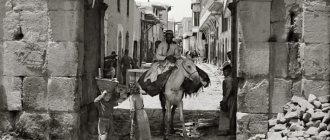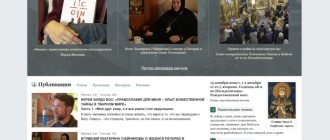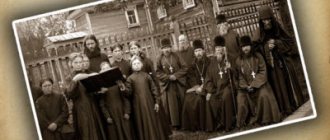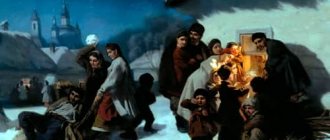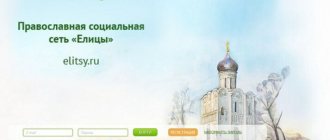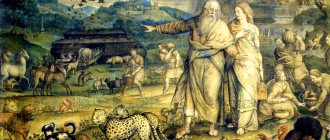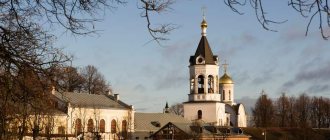| Septuagint, Codex Sinaiticus (fragment), Book of Esther, 2:3-8 |
Codex Sinaiticus
, a manuscript of the Greek Bible, one of the oldest complete codices of the Holy Scriptures of the New Testament. Part of the manuscript of the Old Testament was lost, but the New Testament text was preserved in its entirety. Codex Sinaiticus is the only Greek uncial manuscript containing the complete text of the New Testament. In addition to biblical texts, the codex contains two works by early Christian authors of the century: “The Epistle of Barnabas” and (partially) “The Shepherd” of Hermas (before the discovery of Codex Sinaiticus, the first of these books existed only in a Latin translation, the second was known only by title). In scholarly literature, Codex Sinaiticus is designated by the first letter of the Hebrew alphabet, א (aleph), or the number 01.
Along with the Codex Vaticanus, this text forms the basis of modern critical editions of the New Testament, such as the Nestlé-Alland 27th edition and the United Bible Societies 4th edition.
Fire and secret storage
On November 30, 1971, a strong fire broke out in the Monastery of St. Catherine in Sinai, damaging the northern wall and the adjacent chapel of St. George. In 1975, while making repairs, the monks opened a previously unknown room under the chapel, in which more than three thousand artifacts were discovered - manuscripts, handwritten fragments, early printed books, icons and other objects. By a happy coincidence, a layer of earth on the floor of the chapel saved the contents of the vault from the fire, and among the antiquities found were previously unknown 12 leaves of the famous Codex Sinaiticus of the mid-4th century (one of the oldest copies of the Bible) and another 10 complete and 50 incomplete other medieval manuscript codices.
The monks reported that many of the found manuscripts were written in medieval Caucasian script, possibly Armenian, and only after a visit to the monastery of the patriarch of the Georgian Church it turned out that the language of the manuscripts was ancient Georgian. Therefore, at the first opportunity - and it appeared only in 1990 - an expedition from the Institute of Manuscripts of the Georgian Academy of Sciences, led by the director of the institute, Zaza Aleksidze, came to Sinai to study and catalog the collection.
1 / 6
Detail of a palimpsest photographed in visible light © Jost Gippert / Manana Tandashvili / Goethe-Universität Frankfurt am Main
2 / 6
Fragment of a palimpsest. Image with the top layer removed © Jost Gippert / Manana Tandashvili / Goethe-Universität Frankfurt am Main
3 / 6
Fragment of a palimpsest. Image processing © Jost Gippert / Manana Tandashvili / Goethe-Universität Frankfurt am Main
4 / 6
Fragment of a palimpsest. Image processing © Jost Gippert / Manana Tandashvili / Goethe-Universität Frankfurt am Main
5 / 6
Fragment of a palimpsest. Removing the top layer © Jost Gippert / Manana Tandashvili / Goethe-Universität Frankfurt am Main
6 / 6
Fragment of a palimpsest with a painted lower layer © Jost Gippert / Manana Tandashvili / Goethe-Universität Frankfurt am Main
Peculiarities
The Codex Sinaiticus is written on thin parchment, 38.1 cm by 33.7-35.6 cm. The text on the sheet is arranged in four columns of 48 lines each. Text color is pale brown.
As in the vast majority of ancient manuscripts, the words of the text are written without spaces, using only periods at the end of sentences as divisions. There are no accent or aspiration marks. Text quotations from the Old Testament are not highlighted in the letter. The Partition of Ammonius and the Canons of Eusebius are highlighted in red, and may have been added by another scribe. The entire text is written in Greek uncial script.
Researchers believe that three scribes (called A, B and D) worked on Codex Sinaiticus. In addition, apparently in the period from the century to the 12th century, approximately 9 scribes made adjustments to the text.
There is an assumption that the Codex Sinaiticus is one of the fifty manuscripts of the Divine Scriptures ordered around 331 by Emperor Constantine Eusebius of Caesarea.
Why did you wash the parchment?
Before our era, the main material for manuscripts was papyrus; it is short-lived, and to it we owe so little of the early writings that have reached us. In late ancient times and the early Middle Ages, papyrus was replaced by parchment - finely crafted, most often sheep's skin. Parchment, firstly, is preserved much better in a humid environment, and secondly, it could be produced anywhere, while papyrus was imported exclusively from Egypt.
Another important difference between parchment and papyrus is its reusability: you can wash or scrape off old text from the skin and use the parchment again. This was often used, primarily because parchment was very expensive: monks even complained about this in notes in the margins of manuscripts. For example, among the ancient Georgian manuscripts discovered in 1975 in Sinai, 332 pages were found written in the 10th century over an earlier text. It is known that in the 10th century one sheep's skin dressed as parchment was worth one silver miliaris in Byzantium. From one skin it was possible to make one sheet of parchment, which was folded in half (folio) or four times (quarto), and from it four pages or eight pages were obtained, respectively. Consequently, 332 pages in quarto would cost 42 miliarisia, which at the tenth century exchange rate corresponded to approximately three to three and a half gold solidi (or in Greek - nomism). The annual salary of a Byzantine soldier or sailor in the middle of the 10th century was exactly three solidi, that is, the parchment necessary to create more than 300 pages of text cost about one annual salary of a soldier. Let’s take the salary of an ordinary contract soldier in the Russian army with various allowances - about 20 thousand rubles per month, or approximately 240 thousand rubles per year. This means that in terms of current realities, in order to write these pages, parchment alone would have to be purchased for at least a quarter of a million rubles!
More often than others, manuscripts containing texts by ancient authors were copied: for monks, the main creators of manuscripts of that time, their preservation was a much less pressing need than the creation of liturgical books, that is, performing the direct functions of a scriptorium. In addition, monks washed away old religious texts when church canons changed, and in the early history of the Church this happened quite often. So, for example, the Vulgate of St. Jerome replaced all earlier translations of the Bible into Latin.
Fragment of the Ephraim Code. 5th century Greek biblical manuscript of the 5th century, on which the Greek translation of the 38 homilies of St. Ephraim the Syrian was recorded around the 12th century.
© Bibliothèque nationale de France Sheets of parchment with texts written on top of other texts, previously washed off or scraped off, are called palimpsests (from the Greek παλίμψηστον - “scraped again”), and their study has given science many ancient and early Christian writings that were previously considered lost. The fact is that leather is a porous material into which ink penetrates quite deeply, and even if you wash it off with milk and bran or scrape it off with pumice (as was usually done), traces of texts previously written on it remain under the new layer, and they can be read. To develop old texts, various technologies are used - from chemical processing of parchment, which practically destroys later text (it was used until the beginning of the 20th century), to reading under ultraviolet or infrared rays and radiography, which allows one to identify the smallest inclusions of iron (it was present in the ink, which manuscripts were written in the 1st millennium AD). In addition, chemical processes in the parchment itself usually lead to the fact that the old text, after centuries, itself appears in one way or another on the pages. The study of palimpsests made it possible to discover the “Method of Mechanical Theorems” and “Stomachion” of Archimedes (the famous palimpsest of Archimedes), the treatise “On the State” by Cicero, many ancient historical works, ancient Greek and Roman comedies and tragedies, as well as early versions of the Bible, including those now considered heretical and apocryphal.
Literature[ | ]
Editions of the text
- Scrivener, Frederick Henry Ambrose. A Full Collation of the Codex Sinaiticus with the Received Text of the New Testament
. - Cambridge: Deighton Bell, 1864; 2nd ed. 1867. - Konstantin von Tischendorf, G. Olms (Hrsg.): Bibliorum codex Sinaiticus Petropolitanus.
1. Prolegomena. G. Olms, Hildesheim 1969 (Repr.). - Konstantin von Tischendorf, G. Olms (Hrsg.): Bibliorum codex Sinaiticus Petropolitanus.
2. Veteris Testamenti pars prior. G. Olms, Hildesheim 1969 (Repr.). - Konstantin von Tischendorf, G. Olms (Hrsg.): Bibliorum codex Sinaiticus Petropolitanus.
3. Veteris Testamenti pars posterior. G. Olms, Hildesheim 1969 (Repr.). - Konstantin von Tischendorf, G. Olms (Hrsg.): Bibliorum codex Sinaiticus Petropolitanus.
4. Novum Testamentum cum Barnaba et Pastore. G. Olms, Hildesheim 1969 (Repr.). - Konstantin von Tischendorf, Fragmentum Codicis Friderico-Augustani ex Iesaia et Ieremia
in:
Monumenta sacra inedita
(Leipzig 1855), vol. I, pp. 211 ff. - Kirsopp Lake.
Codex Sinaiticus Petropolitanus: The New Testament, the Epistle of Barnabas and the Shepherd of Hermas. — Oxford: Clarendon Press, 1911.
Other
- Metzger B.
Textology of the New Testament. - M.: BBI, 1999. - P. 44-46. — ISBN 5-87507-011-0. - Anderson, H. T.
The New Testament Translated from the Sinaitic Manuscript Discovered by Constantine Tischendorf at Mt. Sinai (English). — The Standard Publishing Company, 1910. - Gardthausen, Victor (English)Russian.
Griechische paleographie. - Leipzig, 1913. - T. 2. - P. 119-134. - Jongkind, Dirk.
Scribal Habits of Codex Sinaiticus. - Gorgias Press LLC., 2007. - Frederick G. Kenyon.
Our Bible and the Ancient Manuscripts (4th ed.). - London, 1939. - pp. 121-128. - Bruce M. Metzger.
Manuscripts of the Greek Bible: An Introduction to Palaeography. - Oxford: Oxford University Press, 1981. - Tischendorf, Konstantin von.
Die Sinaibibel ihre Entdeckung, Herausgabe, und Erwerbung (German). - Leipzig: Giesecke & Devrient, 1871. - Tischendorf, Konstantin von.
Wann wurden unsere Evangelien verfasst?. — Leipzig: J. C. Hinrichssche Buchhandlung, 1865. - Tischendorf, Konstantin von.
When Were Our Gospels Written?, An Argument by Constantine Tischendorf. With a Narrative of the Discovery of the Sinaitic Manuscript. — New York: American Tract Society (English) Russian, 1866.
Unknown script
Let's return to the Sinai finds of 1975. During the initial study of the found Georgian manuscripts, many of which were so baked in the fire that it was difficult to separate the pages from one another, the attention of Zaza Aleksidze was attracted by two codices, on the pages of which, perpendicular to the Georgian text, traces of an earlier washed-out text were visible: the letters were simultaneously reminiscent of Georgian, Armenian and even Ethiopian alphabets. The fire in the monastery did not so much harm as it helped the researchers: as a result of the effect of heat on the parchment, previously washed out letters appeared on many pages.
In an interview with Azerbaijan International magazine, Zaza Aleksidze said:
"That was incredible! If the wooden floor of the chapel had not been covered with a dense, trampled layer of earth, then when it collapsed in a fire right on top of the manuscript, everything would have burned and turned to ash. And we would never even know about the existence of such documents. But here is Sinai - a mountain of miracles, famous for the fact that, according to the Bible, God gave Moses the Ten Commandments there. The fact that so many pages were sintered together indicates that the heat was enormous. And it is incredible that the pages of parchment did not burn. In addition, an expedition of mice and insects had obviously visited Sinai before me. I would say: “Hey, mouse!” You just chewed up a few letters of one of the rarest alphabets on earth!’”
Notes[ | ]
- ↑ 1 2 Metzger, Bruce M.;
Ehrman, Bart D. The Text of the New Testament: Its Transmission, Corruption, and Restoration. - New York, Oxford: Oxford University Press, 2005. - P. 62. - ↑ 1 2 3 4 5 6
Aland, Kurt and Aland, Barbara (1995).
The Text of the New Testament: An Introduction to the Critical Editions and to the Theory and Practice of Modern Textual Criticism
, transl. Erroll F. Rhodes, Grand Rapids, Michigan: William B. Eerdmans Publishing Company, p. 107—108 - ↑ 1 2
Skeat, T. C. "The Last Chapter in the History of the Codex Sinaiticus",
Novum Testamentum XLII
, 4, pp. 313-315. - Gordon Fee (1968–9). Codex Sinaiticus in the Gospel of John
, NTS 15, pp. 22-44 - Würthwein Ernst (1987). Der Text des Alten Testaments
, Stuttgart: Deutsche Bibelgesellschaft, p. 85. - The Fourth Book of Maccabees is an Old Testament apocrypha found only in the Alexandrian Ex of the Greek Bible. Attributed to Josephus
- Bruce M. Metzger (2001). "A Textual Commentary on the Greek New Testament", Deutsche Bibelgesellschaft
, Stuttgart: United Bible Societies. - Bruce M. Metzger, A Textual Commentary on the Greek New Testament
(Deutsche Bibelgesellschaft: Stuttgart 2001), pp. 315, 388, 434, 444. - The Greek New Testament
, ed.
K. Aland, A. Black, C. M. Martini, B. M. Metzger, and A. Wikgren, in cooperation with INTF, United Bible Societies
, 3rd edition (Stuttgart 1983), p. 16 [UBS3] - Nestle-Aland, Novum Testamentum Graece
, 26th edition, p. 26 [NA26] - The Greek New Testament
, ed.
K. Aland, A. Black, C. M. Martini, B. M. Metzger, and A. Wikgren, in cooperation with INTF, United Bible Societies
, 3rd edition (Stuttgart 1983), p. 164. - Nestle-Aland, Novum Testamentum Graece
, 26th edition, p. 190. - The Greek New Testament
, ed.
K. Aland, A. Black, C. M. Martini, B. M. Metzger, and A. Wikgren, in cooperation with INTF, United Bible Societies
, 3rd edition (Stuttgart 1983), p. 256. - Nestle-Aland, Novum Testamentum Graece
, 26th edition, p.
41 [NA26]; The Greek New Testament
, ed.
K. Aland, A. Black, C. M. Martini, B. M. Metzger, and A. Wikgren, in cooperation with INTF, United Bible Societies
, 3rd edition (Stuttgart 1983), p. 333. - Nestle-Aland, Novum Testamentum Graece
, 26th edition, p. 18 - Nestle-Aland, Novum Testamentum Graece
, 26th edition, p. 24 - Bruce M. Metzger (2001). "A Textual Commentary on the Greek New Testament", Deutsche Bibelgesellschaft
, Stuttgart: United Bible Societies, p. 59 - E. Nestle K. Aland (ed.): Novum Testamentum Graece
, p.
10; K. Aland, M. Black, B. Metzger, A. Wikgren: The Greek New Testament
, p. 13. - Nestle-Aland, Novum Testamentum Graece
, 26th edition, p. 158 - Nestle-Aland, Novum Testamentum Graece
, 26th edition, p. 264 - ↑ 1 2
Metzger, Bruce M. (1991).
Manuscripts of the Greek Bible: An Introduction to Palaeography, Oxford: Oxford University Press
, p. 76 - Lumbroso, G. (1879). Atti della R. Accademia dei Lincei
, p. 501 - K. Lake, Codex Sinaiticus Petropolitanus: The New Testament, the Epistle of Barnabas and the Shepherd of Hermas
. p. V. - Konstantin von Tischendorf, Monumenta sacra inedita
(Leipzig 1855), vol. I, pp. 211 ff. - Tischendorf, K. v. (1866). When Were Our Gospels Written?
An Argument by Constantine Tischendorf. With a Narrative of the Discovery of the Sinaitic Manuscript , New York: American Tract Society. - Porfiry (Uspensky), First trip to the Sinai Monastery in 1845, Petersburg 1856, p. 226
- Caspar René Gregory, Textkritik des Neuen Testaments
(Leipzig 1900), Vol. 1, p. 195 - ↑ 1 2 Metzger, Bruce M.;
Ehrman, Bart D. The Text of the New Testament: Its Transmission, Corruption, and Restoration. - New York, Oxford: Oxford University Press, 2005. - P. 63. - A document on the rights to Sinai ex was found in the archives of the Russian Foreign Ministry Lenta.ru
- K. Lake, Codex Sinaiticus Petropolitanus: The New Testament, the Epistle of Barnabas and the Shepherd of Hermas
, Oxford: Clarendon Press, 1911, p. VI. - ↑ 12
Simonides' strange announcement about the Sinai ex and Tischendorf's response - McKitterick, David (1998) A history of Cambridge University Press
, Volume 2:
Scholarship and Commerce (1698–1872)
, Cambridge: Cambridge University Press, ISBN 0-521-30802-X, p. 369 - Beneshevich Vladimir Nikolaevich, “Archaeological and paleographic monuments of Sinai”, Vol. 2, Sankt Petersburg, 1912; VN Beneshevich, “Catalogus Codicum Manuscriptorum Graecorum qui in Monasterio Sanctae Catherinae in Monte Sina Asservantur” St. Petersburg (1911).
- Codex Sinaiticus
- Ο Σιναϊτικός Κώδικας.
- Milne, H. J. M.; Skeat, T. C. Scribes and Correctors of the Codex Sinaiticus
, London: British Museum, 1938 - Codex Sinaiticus finds 1975 Archived June 29, 2008. with images
- Oldest Bible fragment found in Egypt Press TV
- World's oldest Bible goes global: Historic international digitization project announced, British Library: Press Room
- Oldest known Bible to go online
- BBC: The oldest Bible was “posted” on the Internet
- About Codex Sinaiticus. Content
- D. Jongkind, Scribal Habits of Codex Sinaiticus
, pp. 22—50, 67—68 - Milne, H. J. M.; Skeat, T. C. Scribes and Correctors of the Codex Sinaiticus
, London: British Museum, 1938, pp. 22-50. - ↑ 1 2
Metzger, Bruce M. (1991).
Manuscripts of the Greek Bible: An Introduction to Palaeography, Oxford: Oxford University Press
, p. 77 - Price, I. M. (1923). The Ancestry of Our English Bible an Account of Manuscripts, Texts and Versions of the Bible
, Sunday School Times Co, p. 146 f. - Pierre Batiffol, Codex Sinaiticus
, in DB. 1, 1883-1886. - Skeat, T. C. (1999). The Codex Sinaiticus, The Codex Vaticanus and Constantine
. Journal of Theological Studies 50: 583–625.
Language of Caucasian Albania
Stone capital of the 5th–6th centuries with an inscription in Albanian, found during excavations of the Sudagylan settlement near the city of Mingachevir, modern Azerbaijan © Gulustan / Wikimedia Commons
In 1996, during his third expedition to Sinai, Aleksidze tested one of his hypotheses and compared the alphabet of early layers of palimpsest with inscriptions found on walls and utensils during excavations of ancient Christian churches in the area of the Azerbaijani city of Mingachevir. And then it became clear: in front of him were texts written in the language of Caucasian (named so as to distinguish it from the more famous Balkan) Albania. This state existed for about five centuries, starting around the end of the 2nd century BC on the territory of modern Southern Dagestan and Azerbaijan. Albania later became part of Persia, then was conquered by the Arabs, and then by the Turks, with the accompanying Islamization. Despite the enormous Armenian cultural influence, ethnically Caucasian Albania apparently consisted of the predecessors of the modern Dagestan peoples, its official religion was Christianity, and its official language was the Caucasian-Albanian language, about which very little was known: firstly, it was mentioned in medieval sources, secondly, the same inscriptions found near Mingachevir were known, and, thirdly, in 1937, historian Ilya Abuladze found an Armenian grammar of the 15th century, supplemented by various medieval alphabets, one of which was signed as Albanian.
Having analyzed the alphabet found by Abuladze, Georgian philologist Akaki Shanidze, based on the similarity of the phonetic system, suggested that the language of Caucasian Albania was the ancestor of the modern Udi language (it belongs to the Lezgin group of the Nakh-Dagestan family), which is spoken by about eight thousand people living in the current territory of Azerbaijan . However, the scarcity of sources did not allow us to confirm this hypothesis.
How to decipher an unknown alphabet
Now, realizing that this was the language of Caucasian Albania, Aleksidze set himself the task of deciphering its writing:
“In 1996, I began using an ultraviolet lamp, which was in the monastery in Sinai, to read palimpsests. Ultraviolet light is not very effective unless used in a dark room. But the only dark room in the monastery was the toilet. Burning with the desire to quickly read the manuscripts, I went to the toilet, locked myself there, sat on the nightstand and rewrote the texts. It was so cramped there that I had to perform an almost acrobatic act - put the manuscript on my knees, hold the ultraviolet lamp with my left hand, and copy the letters into a notebook with my right. And so hour after hour, day after day, week after week. Unfortunately, I did not realize at the time that working with ultraviolet light, even for a limited time, could be dangerous. As a result, I seriously injured my left eye. In truth, if you were to ask me now whether I was ready to repeat this work, I am sure that I would not doubt the answer for a second. Breaking a new path in science is always difficult, but when there is a result in the end, it is so inspiring that you forget about all the difficulties along the way.”
Rosetta Stone. Illustration from the book “Gallery of Antiquities, Selected from the British Museum”. 1842 The stone, discovered in 1799, contained three identical texts written in ancient Egyptian hieroglyphs, Egyptian demotic and ancient Greek.
The comparison of these texts allowed Jean François Champollion to decipher ancient Egyptian hieroglyphs by 1822. © archive.org He began with the same thing with which Jean François Champollion once began deciphering Egyptian hieroglyphs: he tried, using Abuladze’s alphabet, to find proper names in the texts in order to advance further understanding of the texts on their basis. He was one of the first to isolate words that resembled the Greek place names “Thessaloniki” and “Corinth”. From this he made the assumption that this was a translation of one of the New Testament epistles to the Corinthians. And so it turned out: using the dictionary and grammar of the modern Udi language, as well as comparing the syntactic structures of the text with the Bible, Aleksidze absolutely reliably read the Second Epistle of the Apostle Paul to the Corinthians. It turned out that in the 15th century manuscript the Caucasian-Albanian alphabet was presented extremely inaccurately: the compiler was clearly not a native speaker and used some older source. At first, this caused a lot of difficulties in deciphering, but later the researcher was able to create his own table of correspondences, much more accurate:
“And now I finally managed to crack this code. Until a few years ago, scientists doubted whether the Albanians had a written language at all. My work confirmed that an alphabet existed, large texts were written in it, and it was possible to decipher it. These strange letters suddenly took on meaning. You can't even imagine how excited I was! Such a discovery changes not only the soul, but the whole organism. I asked myself: is this true? Is this really the correct meaning of these letters? I did not tell anyone about my discovery except the closest members of my family. I had to be one hundred percent sure before making any public statement. I was so overcome with emotion that I could not work for several days, although I was full of enthusiasm to continue transcribing. I had to stop. It was impossible to continue. I needed to calm down and realize the fact that I still managed to decipher the Caucasian-Albanian alphabet. I could finally say: “This is Albanian.” And I can read it!”
History of the discovery of Codex Sinaiticus
Codex Sinaiticus is one of the oldest complete codexes of the Holy Scriptures of the New Testament. Along with the Codex Vaticanus, this text forms the basis of modern critical editions of the New Testament, such as the Nestlé-Alland 27th edition and the United Bible Societies 4th edition. Unfortunately, in the descriptions of the discovery of this wonderful codex, the name of the archbishop is practically not mentioned. Porfiry Uspensky, who made a significant contribution to the study of the manuscript. In 1844, while traveling in search of ancient manuscripts, the young German scientist Constantin von Tischendorff arrived at the monastery of St. Catherine on Mount Sinai. He was a tireless searcher for ancient manuscripts with the goal of restoring the original text of the Holy Scriptures of the New Testament. In a letter to his fiancee, Tischendorf wrote: “I have a sacred goal before me - to recreate the true form of the New Testament text.” In the monastery of St. Catherine then had three libraries, located in three separate rooms, and in them, according to Tischendorf, there were about 500 ancient manuscripts. However, he will write in his diary entries that he did not find anything relating to the early stage of the formation of the New Testament text. His Grace Porfiry gives a slightly different assessment of the events: “The Greek monks, under various pretexts, did not show him (Tischendorf) the precious manuscripts kept in the secret places of their holy monasteries. These monks, long frightened by the firmans of the Porte, who authorized European travelers to penetrate the sacristies and book depositories of Orthodox monasteries, and offended by unfavorable reviews about them in travel descriptions, partly rightly evaded the requests of Tischendorf, who did not and does not have the main attractive force, i.e. confession of the Orthodox faith"[1].
Further events are reconstructed by biographers from Tischendorf’s diary. One day, while working in the main library of the monastery, he saw a basket full of sheets of an ancient manuscript. The scientist examined the sheets - it was an ancient copy of the Septuagint, written in a beautiful uncial script. A monk-librarian approached and said that two such baskets had already been put on fire and the contents of this basket should also be burned. Tischendorf asked not to do this, citing the value of the ancient manuscript. There were 43 sheets in the basket, and the scientist found another 86 sheets of the same codex in the library. In terms of content, these were: the 1st book of Kings, the book of the prophet Jeremiah, the book of Ezra and Nehemiah, the book of the prophet Isaiah, the 1st and 4th books of Maccobees. At the monastery, Tischendorf was allowed to take 43 sheets, which he then published in Germany. The Codex was named “Frederico-Augustinian” in honor of the King of Saxony, who at that time patronized the scientist. Subsequently, Tischendorf visited Sinai twice more, the third time under the patronage of Russia, which resulted in a complete facsimile edition of the Codex Sinaiticus in 1862 under the title “Codex Bibliorum Sinaiticus Petropolitanus, rescued from obscurity under the patronage of His Imperial Majesty Alexander II, delivered to Europe and published for the greater good and glory of Christian teaching through the works of Konstantin Tischendorf.”
But let's go back to 1845. In April-May, to the monastery of St. Catherine arrived Archimandrite. Porfiry Uspensky, where he also discovered the leaves of the Codex Sinaiticus, and not only the 86 leaves that Tischendorf was not allowed to take out during his first visit to the monastery, but also the remaining parts of the Old Testament and the entire New Testament. This is how the archimandrite himself describes it. Porfiry: “The first manuscript containing the Old Testament incomplete and the entire New Testament with the epistle of St. Barnabas and the book of Hermas, written on the thinnest white parchment. <…> The letters in it are completely similar to Church Slavonic ones. Their production is direct and continuous. There are no aspirations or stresses above the words, and sentences are not separated by any spelling marks other than periods. The entire sacred text is written in four and two columns in a stichomerical manner and so seamlessly, as if one long utterance stretches from point to point.”[2] Subsequently, analyzing the text, Archimandrite Porfiry, dating it to the 5th century, suggested that it was rewritten from the Alexandrian list, and may have been related to the Alexandrian catechetical school, since it was not used during divine services. The text currently dates back to the 4th century. Konstantin Tischendorf was the first to date the text in this way; later, Vladyka Porfiry was also ready to revise his dating (5th century).
The Codex Sinaiticus was in the Imperial Public Library until 1930; in 1930 it was sold to the British Museum Library for £100,000. Most of the information about the discovery of Codex Sinaiticus mentions virtually nothing about the writings of Archbishop Porphyry. Already in the 19th century, the outstanding Russian liturgist A. A. Dmitrievsky from distant countries “received, as a special mercy, pitiful grains, at a time when they could have had a whole loaf in their hands”[3]. One can disagree with the statement of A. A. Dmitrievsky that Vladyka Porfiry was the first to discover the Codex Sinaiticus, since Tischendorf saw the Codex Sinaiticus a year earlier. Only a fair remark regarding the oblivion of the works of Vladyka Porfiry, because the result of his scientific activity was the book “Opinion on the Sinai manuscript, containing not completely the Old Testament and the entire New Testament with the epistle of the holy Apostle Barnabas and the book of Hermas,” published in 1862.
1 Materials for the biography of Bishop Porfiry Uspensky. St. Petersburg, 1910, vol. II, p. 682.
2 Porfiry (Uspensky), archimandrite. The first trip to the Sinai monastery in 1845. St. Petersburg, 1856, p. 226.
3 Dmitrievsky A. A. Traveling in the East and its scientific results. Kyiv, 1890, p. 6.
December 10, 2003
Press service of the St. Petersburg diocese
The oldest lectionary
Subsequently, German linguists Wolfgang Schulze and Jost Gippert, specialists in Caucasian languages, as well as Jean Pierre Maheu, a French philologist and historian of Christianity, were involved in the decryption work, and the palimpsest was identified as a lectionary - a collection of biblical texts used during services and compiled approximately in the 5th century. What is interesting is that in its composition this lectionary does not coincide with any of the known lectionaries not only in Armenian or Georgian, but also in other languages - this means that, most likely, it was compiled directly in the Middle East and is a direct translation from an unsurvived ancient Greek original. This may be the oldest lectionary known today. Most likely, the scribes who erased its text from the parchment did not know the Caucasian-Albanian writing and did not understand what was written there.
In 2009, a team of four authors published a two-volume book with the texts of the lectionary and fragments of the Gospel of John, as well as a grammatical outline of the Caucasian-Albanian language in the Belgian publishing house Brepols.
The discovery and study of Caucasian-Albanian palimpsests made it possible to make a significant contribution to several scientific disciplines at once: to complete the deciphering of the alphabet, previously known only from fragmentary sources; obtain a large amount of information about the grammar of an ancient language that had previously remained unstudied; learn a lot about the history of Christianity in the Caucasus and the Middle East, as well as about the history of the state of Caucasian Albania and discover one of the oldest examples of liturgical collections. Among other things, this is the discovery of a whole layer of history of the Udi people, whose language and culture are now on the verge of extinction.

